
产品分类:兼容思科系列

| H3C 华三 | ZTE 中兴 | Huawei | CSICO 思科 | ZYXEL 合勤 | HP 惠普 | zyxel合勤 | Linksys |
| DCN | extrem | RedBack | Juniper | 3COM | Ruijie | Netgear | ALPHQ |
| Bdcom | D-link | Avaya | alcatel | AlliedTelesis | Intel | Nortel | SMC |
| Dell | Emulex | Enterasys | Feixun | Force10 | Brocade | Adtran | IPTIME |
| Hirschmann | IBM | Asante | Motorola | Linksys | Marconi | Foundry | Maipu |
| McAfee | Blade | Nortel | Planet | Q-logic | SMC | IP-COM | Asante |
| SUN | Telco | TRENDnet | Vixel | Broadcom | Marvell | TENDA | TP-link |
| 磊科 | HILLSTONE | XIRCOM | 水星网络 | 欣全 | VIGOR | 港湾 | AMD |
| 侠诺 | 艾泰 | 飞鱼星 | 博威 | 五舟 | 摩羯 | Marvell | Samsung |
| 宝德 | 飞迈瑞克 | JCG | Altera | 世纪飞扬 | 浪潮 | 清华同方 | 华硕/联想 |
☉如果需要详细的数据手册,请联系我们的SALES,谢谢!
☉如果应用中遇到什么问题,请联系我们的FAE,我们将为你提供更多 、更好的资源!
The Cisco® enhanced wavelength-division multiplexing (EWDM) product line allows users to scale the speed and capacity of the services offered in a coarse wavelength-division multiplexing (CWDM) network by offering the ability to insert up to 8 dense wavelength-division multiplexing (DWDM) wavelengths to the existing 8-wavelength CWDM channel plan.
Product Overview
Figure 1. Cisco EWDM Concept
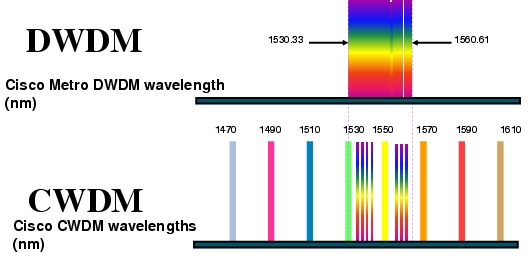
Figure 2. EWDM Passive Units Front Panel
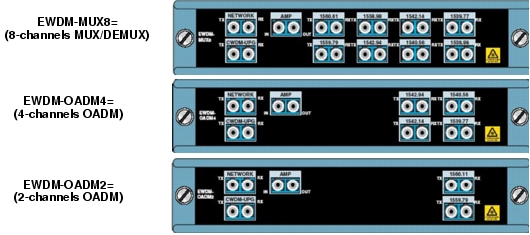
Figure 3. Cisco EWDM Channel Plan
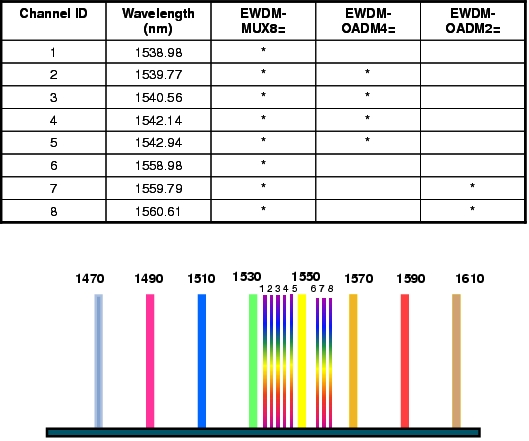
Figure 4. EWDM Optical Amplifier

Benefits of Cisco EWDM
• EWDM is built from the start with 10 Gbps in mind: customers can use DWDM technology to scale the speed of the services supported in a CWDM network.
• Customers can grow existing CWDM infrastructures to 16 total wavelengths. Adding DWDM channels does not sacrifice any of the 8 CWDM wavelengths.
• While upgrading to 10 Gbps, customers do not have to sacrifice the reach of their networks because of the reduced performance of 10-Gbps optics. The optical amplifier, designed for plug-and-play operations, will boost the power of 10-Gbps channels to match to total power budget available on CWDM lower speed services.
Applications
Figure 5. Example Deployment Scenario (West-to-East Direction Only Shown)
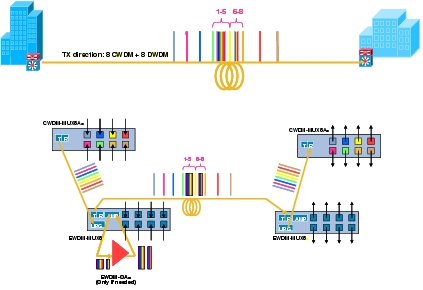
1. The CWDM "NETWORK TX" port, carrying the 8 CWDM wavelengths, is connected to the "CWDM-UPG RX" port of the EWDM unit. (The CWDM wavelengths are now ready to be multiplexed together with the DWDM wavelengths.)
2. 2. At the same time, the EWDM passive device receives from its DWDM client ports the signals from 10 Gigabit Ethernet transceivers, multiplexes them together, and routes them out of the "AMP IN" port.
a. If the overall loss experienced by the 10 Gigabit Ethernet wavelengths can be accommodated within the power budget of the 10 Gigabit Ethernet DWDM transceiver (for example, a DWDM Xenpak has 20 dB of power budget after ~80 km, taking into account dispersion penalties), simply use the single-mode simplex LC patch cord provided with the EWDM device to connect the "AMP IN" to the "AMP OUT." This way the DWDM wavelengths are fed back into the EWDM device ready to be multiplexed together with the CWDM signals.
b. If the 10 Gigabit Ethernet channels require extra power to match the power budget of the CWDM GBIC/SFP devices, then the DWDM wavelengths out of the "AMP IN" port have to be injected into the "IN" port of the EWDM-OA=. The "OUT" port of the amplifier then feeds back the amplified signals into the "AMP OUT" port of the EWDM passive device. This way the DWDM wavelengths are fed back into the EWDM device ready to be multiplexed together with the CWDM signals.
3. At this stage the EWDM unit performs the multiplexing operation of CWDM and DWDM wavelengths. The aggregate CWDM plus DWDM signal is then sent out of the EWDM "NETWORK TX" port connected to the "metro" fiber.
4. At the receiving end, the "metro" fiber is connected to the EWDM "NETWORK RX" port, which receives all the CWDM and DWDM wavelengths. The DWDM wavelengths are demultiplexed and routed to the client "TX" ports connected to the 10 Gigabit Ethernet transceivers (hosted in a Cisco Catalyst® line card, for example). The CWDM wavelengths pass through the EWDM device transparently and are directed out of the "CWDM-UPG TX" port.
5. The "CWDM-UPG TX" port is connected to the "NETWORK RX" port of the CWDM units in Figure 5. The CWDM device demultiplexes the CWDM wavelengths and directs them to the receivers of the CWDM transceivers (hosted in a Cisco Catalyst or MDS line card, for example).
Other Possible Applications
Point-to-point DWDM link
Figure 6. Unamplified 8-Channel DWDM Link (West to East Only Shown)

Figure 7. Amplified 8-Channel DWDM Link (West to East Only Shown)
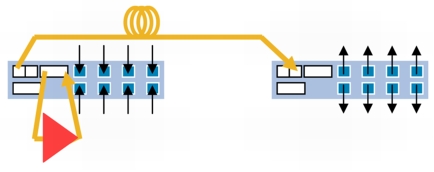
Small all-optical hubs and rings
Figure 8. 2-Channel Hub and Spoke Topology (West to East Only Shown)

Figure 9. 2-Channel Protected Ring Topology (Drop Path Shown in Each Direction)

CWDM over DWDM
Figure 10. CWDM Channel Dropped Between 2 EWDM Filters (Drop Path Shown in Each Direction)

EWDM Passive Unit Product Specifications
Figure 11. EWDM Passive Unit Front Panel Layout

Table 1. EWDM-MUX8 Passive Unit Optical Specifications
|
Parameter |
Path |
Min |
Max |
Unit |
|
Operating Band |
1460-1620 |
Nm |
||
|
Channel Spacing |
100 |
GHz |
||
|
DWDM Channel 0.5 dB Bandwidth |
-0.12 |
+0.12 |
Nm |
|
|
DWDM Channel |
1 to 8 |
|||
|
Insertion Loss |
Mux DWDM (channel) |
3.5 |
dB |
|
|
Demux DWDM (channel) |
2.5 |
|||
|
Mux CWDM (band) |
1 |
|||
|
Demux CWDM (band) |
1.5 |
|||
|
Combined Mux Demux DWDM (same channel) |
4.7 |
|||
|
Isolation |
Pass Port Isolation (In band Isolation) |
15 mux |
dB |
|
|
Adjacent channels Isolation (DWDM Channels over DWDM or CWDM channels) |
30 demux |
|||
|
Return Loss |
45 |
dB |
||
|
Directivity |
50 |
dB |
||
|
PDL |
All Paths |
0.2 |
dB |
|
|
PMD |
All Paths |
0.2 |
ps |
|
|
Optical Loss Uniformity |
1.5 |
dB |
||
|
Max Optical Input Power |
300 |
mW |
||
Table 2. EWDM-OADM4 Passive Unit Optical Specifications
|
Parameter |
Path |
Min |
Max |
Unit |
|
Operating Band |
1460-1620 |
Nm |
||
|
Channel Spacing |
100 |
GHz |
||
|
DWDM Channel 0.5 dB Bandwidth |
-0.12 |
+0.12 |
nm |
|
|
DWDM Channel |
2,3,4,5 |
|||
|
Insertion Loss |
Mux DWDM (channel) |
3.5 |
dB |
|
|
Demux DWDM (channel) |
2.5 |
|||
|
Mux CWDM (band) |
1 |
|||
|
Demux CWDM (band) |
1.5 |
|||
|
Combined Mux Demux DWDM (same channel) |
3.7 |
|||
|
Isolation |
Pass Port Isolation |
15 mux 30 demux |
dB |
|
|
Adjacent channels Isolation (DWDM Channels over DWDM or CWDM channels) |
30 |
|||
|
Return Loss |
45 |
dB |
||
|
Directivity |
50 |
dB |
||
|
PDL |
All Paths |
0.2 |
dB |
|
|
PMD |
All Paths |
0.2 |
ps |
|
|
Optical Loss Uniformity |
1 |
dB |
||
|
Max Optical Input Power |
300 |
mW |
||
Table 3. EWDM-OADM2 Passive Unit Optical Specifications
|
Parameter |
Path |
Min |
Max |
Unit |
|
Operating Band |
1460-1620 |
Nm |
||
|
Channel Spacing |
100 |
GHz |
||
|
DWDM Channel 0.5 dB Bandwidth |
-0.12 |
+0.12 |
nm |
|
|
DWDM Channel |
7 and 8 |
|||
|
Insertion Loss |
Mux DWDM (channel) |
2 |
dB |
|
|
Demux DWDM (channel) |
2 |
|||
|
Mux CWDM (band) |
1 |
|||
|
Demux CWDM (band) |
1 |
|||
|
Combined Mux Demux DWDM (same channel) |
3.1 |
|||
|
Isolation |
Pass Port Isolation |
15 mux 30 demux |
dB |
|
|
Adjacent channels Isolation (DWDM Channels over DWDM or CWDM channels) |
30 |
|||
|
Return Loss |
45 |
dB |
||
|
Directivity |
50 |
dB |
||
|
PDL |
All Paths |
0.2 |
dB |
|
|
PMD |
All Paths |
0.2 |
ps |
|
|
Optical Loss Uniformity |
1 |
dB |
||
|
Max Optical Input Power |
300 |
mW |
||
Table 4. EWDM Passive Unit Add/Drop losses
|
Model |
Maximum Insertion Loss (dB) |
||
|
Add+Drop DWDM |
Add CWDM |
Drop CWDM |
|
|
EWDM-MUX8= |
4.71 |
1 |
1.5 |
|
EWDM-OADM4= |
3.72 |
1 |
1 |
|
EWDM-OADM2= |
3.13 |
1 |
1 |
|
1If the link is terminated with another EWDM-MUX8= device. If a different EWDM device terminates the link, the "DWDM ADD" insertion loss is 3.5 dB, and the "DWDM DROP" insertion loss is 2.5 dB.
2If the link is terminated with another EWDM-OADM4= device. If a different EWDM device terminates the link, the "DWDM ADD" insertion loss is 2.5 dB, and the "DWDM DROP" insertion loss is 2.5 dB.
3If the link is terminated with another EWDM-OADM2= device. If a different EWDM device terminates the link, the "DWDM ADD" insertion loss is 2 dB, and the "DWDM DROP" insertion loss is 2 dB.
|
Table 5. EWDM Passive Unit Environmental Conditions
|
Parameter |
Min/Max Value |
|
Operating Temperature |
-5 ~ 55ºC |
|
Storage Temperature |
-40 to 85ºC |
|
Operating Humidity |
5 to 95%RH |
EWDM Optical Amplifier Unit Product Specifications
Figure 12. EWDM Amplifier Front Panel Layout

• 3 LEDs to report the status of the device (Table 6)
• A hardware reset button (next to the alarm LED) (Table 7)
• An RS-232 interface with RJ45 connector (Table 8)
• An AC power plug (Table 9)
• The optical input and output ports based on LC connectors (Table 10)
Table 6. EWDM Front Panel LED State
|
Functionality |
Possible State |
Comment |
|
Power |
Ok |
Green |
|
Starting up |
Green |
|
|
Failure |
Red |
|
|
Input power alarm |
In range |
Green |
|
Out of range |
Red |
|
|
Alarm LED |
Normal condition |
Green |
|
Minor problem |
Orange |
|
|
Severe problem |
Red |
Table 7. EWDM Amplifier Unit Optical Specifications
|
Parameter |
Min |
Typ |
Max |
Unit |
|
Total operating signal wavelength range |
1538.2 |
1561.4 |
nm |
|
|
Total output power |
17.5 |
dBm |
||
|
Total input power |
-4.5 |
9.5 |
dBm |
|
|
Per channel input power |
-4.5 |
2.5 |
dBm |
|
|
Single channel output power |
3.5 |
12 |
dBm |
|
|
Gain |
7.5 |
8 |
8.5 |
dB |
|
Gain flatness |
-0.5 |
+0.5 |
dB |
|
|
Noise figure |
10 |
dB |
||
|
Return loss |
40 |
dB |
||
|
PDG |
-0.25 |
+0.25 |
dB |
|
|
PMD |
0.3 |
ps |
Table 8. RS-232 Requirements
|
Parameter |
Value |
|
Data bits |
8 |
|
Parity |
No parity |
|
Stop bits |
1 |
|
Speed |
9600 |
Table 9. Console Port Signaling and Cabling
|
Item |
Comment |
Min |
Type |
Max |
Unit |
|
External voltage supply |
85 |
110 or 220 |
265 |
V |
|
|
Power consumption |
10 |
W |
|||
|
Cold startup time: Electrical |
5 |
S |
|||
|
Maximum inrush power dissipation |
Max 3 minutes |
40 |
W |
||
|
Maximum inrush power current |
@ 100 VAC, @ 25C |
15 |
A |
||
|
@ 200 VAC, @ 25C |
30 |
A |
Table 10. Console Port Signaling and Cabling
|
Console Port (DTE) |
RJ-45-to-RJ-45 Rollover Cable |
Console Device |
|
|
Signal |
RJ-45 Pin |
RJ-45 Pin |
Signal |
|
RTS1 |
1 |
8 |
CTS2 |
|
No connection |
2 |
7 |
DSR |
|
TxD3 |
3 |
6 |
RxD4 |
|
GND5 |
4 |
5 |
GND |
|
GND |
5 |
4 |
GND |
|
RxD |
6 |
3 |
TxD |
|
No connection |
7 |
2 |
DTR6 |
|
CTS |
8 |
1 |
RTS |
Ordering Information
Table 11. Ordering Information
|
Product Name |
Part Number |
|
Cisco EWDM MUX/DEMUX 8 wavelengths |
EWDM-MUX8= |
|
Cisco EWDM MUX/DEMUX and OADM 4 wavelengths |
EWDM-OADM4= |
|
Cisco EWDM MUX/DEMUX and OADM 2 wavelengths |
EWDM-OADM2= |
|
Cisco EWDM optical amplifier |
EWDM-OA= |